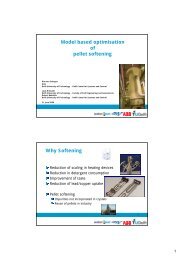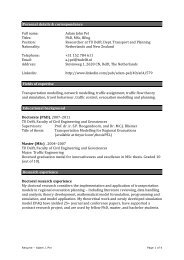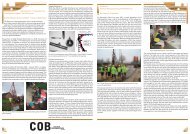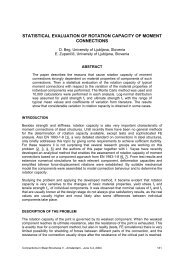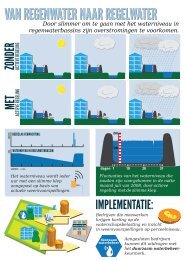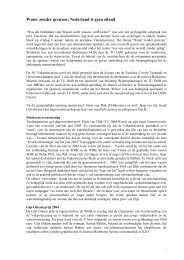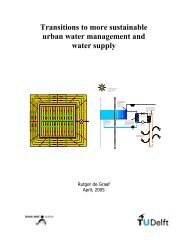Pedestrian route-choice and activity scheduling theory and models
Pedestrian route-choice and activity scheduling theory and models
Pedestrian route-choice and activity scheduling theory and models
Create successful ePaper yourself
Turn your PDF publications into a flip-book with our unique Google optimized e-Paper software.
S.P. Hoogendoorn, P.H.L. Bovy / Transportation Research Part B 38 (2004) 169–190 173<br />
pedestrian may have some freedom to choose where <strong>activity</strong> i from S is performed. This is<br />
modeled by considering different <strong>activity</strong> areas A ij X with j ¼ 1; ...; J i , where <strong>activity</strong> i can be<br />
performed. For example, a traveler can ‘‘buy a newspaper’’ at different ticket machines or ticket<br />
offices.<br />
Terminal time T i for <strong>activity</strong> i denotes the instant at which <strong>activity</strong> i is completed. That is, the<br />
difference T i T i 1 equals the expected walking time <strong>and</strong> the time needed to perform <strong>activity</strong> i.<br />
Together with the <strong>route</strong> xðÞ through the facility, the terminal time determines the <strong>activity</strong> area A ij<br />
chosen by the pedestrian, i.e. xðT i Þ2A ij (assuming that the pedestrian will not move while performing<br />
the <strong>activity</strong>). The <strong>route</strong> xðÞ is a continuous function, uniquely determined by the velocity<br />
path vðÞ<br />
xðÞ :¼ fxðsÞ 2Xjt 0 6 s 6 t 1 s:t: _xðsÞ ¼vðsÞ <strong>and</strong> xðt 0 Þ¼x 0 g ð1Þ<br />
4.3. Subjective utility optimization at the tactical level<br />
We hypothesize that at the tactical level, a pedestrian makes a simultaneous decision at time t 0<br />
minimizing the expected disutility or cost C. This decision will cover all decision variables described<br />
in the previous section (<strong>activity</strong> patterns S, terminal times T i , <strong>and</strong> the velocity path vðÞ).<br />
The expected disutility C ¼ CðS; fT i g i2S<br />
; vðÞjt 0 ; x 0 Þ of the combined <strong>choice</strong> of a pedestrian entering<br />
the walking facility at instant t 0 at location x 0 stems from performing specific activities at certain<br />
<strong>activity</strong> areas, the order in which the activities are performed, <strong>and</strong> the expected cost of walking<br />
between the <strong>activity</strong> areas. We assume that the total disutility can be written as follows<br />
CðS; fT i g i2S<br />
; vðÞjt 0 ; x 0 Þ :¼ X i2S<br />
C i ðT i ; vðÞjT i 1 ; xðT i 1 ÞÞ þ wðSÞ ð2Þ<br />
where C i denotes the combined cost of walking from the location xðT i 1 Þ2A i 1j to xðT i Þ2A ij<br />
where <strong>activity</strong> i is performed, <strong>and</strong> the cost (or utility U ij ) of performing <strong>activity</strong> i at <strong>activity</strong> area<br />
A ij ; w denotes the cost of the <strong>activity</strong> <strong>scheduling</strong> (e.g. due to the specific order of activities). In the<br />
remainder, the components C i are specified. Subjective utility optimization then yields that the<br />
pedestrian makes the following combined <strong>choice</strong> at the tactical level<br />
ðS ; fT i g i2S ; v ðÞÞ ¼ arg minCðS; fT i g i2S<br />
; vðÞjt 0 ; x 0 Þ<br />
ð3Þ<br />
Activity i may be performed at multiple <strong>activity</strong> areas A ij , yielding different utilities U ij . These<br />
differences reflect personal preferences for using a certain area (e.g. describing that pedestrians<br />
expect different waiting times at different ticket offices). Some activities are discretionary, others<br />
are m<strong>and</strong>atory, which is described by high penalties / i experienced when <strong>activity</strong> i is not performed.<br />
The order in which activities are performed generally depends on the directness (Helbing,<br />
1997) <strong>and</strong> results from the simultaneous <strong>choice</strong>s made at the tactical level. Directness is reflected<br />
by the cost stemming from the trajectory xðÞ; wðSÞ is generally only used describe that the <strong>activity</strong><br />
order is restricted, implying that some activities can be performed only once others are completed.<br />
Although pedestrian <strong>route</strong> <strong>choice</strong> is mostly subconscious, assuming that <strong>route</strong> <strong>choice</strong> strategies<br />
are applicable to predict pedestrian <strong>choice</strong> behavior is fruitful from a modeling viewpoint (Hill,<br />
1982). We therefore assume that the pedestrian <strong>route</strong> <strong>choice</strong> is based on utility optimization. The<br />
disutility C i of a <strong>route</strong> will depend among other things on (Chiolek, 1978; Gipps, 1986):



